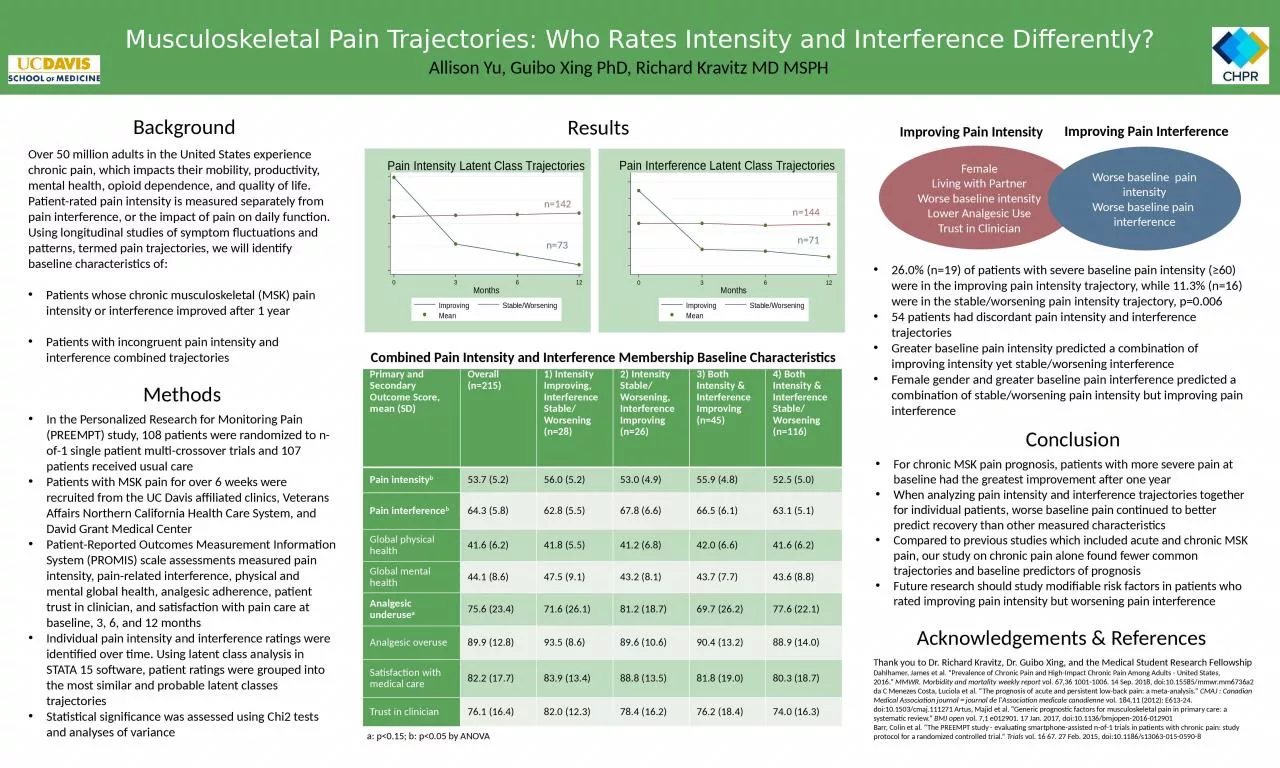

Allison Yu Guibo Xing PhD Richard Kravitz MD MSPH Background Results Primary and Secondary Outcome Score mean SD Overall n215 1 Intensity Improving Interference Stable Worsening n28 ID: 1043469
Download Presentation The PPT/PDF document "Musculoskeletal Pain Trajectories: Who R..." is the property of its rightful owner. Permission is granted to download and print the materials on this web site for personal, non-commercial use only, and to display it on your personal computer provided you do not modify the materials and that you retain all copyright notices contained in the materials. By downloading content from our website, you accept the terms of this agreement.
1. Musculoskeletal Pain Trajectories: Who Rates Intensity and Interference Differently?Allison Yu, Guibo Xing PhD, Richard Kravitz MD MSPHBackgroundResultsPrimary and Secondary Outcome Score, mean (SD)Overall(n=215)1) Intensity Improving, Interference Stable/Worsening(n=28)2) Intensity Stable/Worsening, Interference Improving(n=26) 3) Both Intensity & Interference Improving(n=45)4) Both Intensity & Interference Stable/ Worsening(n=116)Pain intensityb53.7 (5.2)56.0 (5.2)53.0 (4.9)55.9 (4.8)52.5 (5.0)Pain interferenceb64.3 (5.8)62.8 (5.5)67.8 (6.6)66.5 (6.1)63.1 (5.1)Global physical health41.6 (6.2)41.8 (5.5)41.2 (6.8)42.0 (6.6)41.6 (6.2)Global mental health44.1 (8.6)47.5 (9.1)43.2 (8.1)43.7 (7.7)43.6 (8.8)Analgesic underusea75.6 (23.4)71.6 (26.1)81.2 (18.7)69.7 (26.2)77.6 (22.1)Analgesic overuse89.9 (12.8)93.5 (8.6)89.6 (10.6)90.4 (13.2)88.9 (14.0)Satisfaction with medical care82.2 (17.7)83.9 (13.4)88.8 (13.5)81.8 (19.0)80.3 (18.7)Trust in clinician76.1 (16.4)82.0 (12.3)78.4 (16.2)76.2 (18.4)74.0 (16.3)a: p<0.15; b: p<0.05 by ANOVACombined Pain Intensity and Interference Membership Baseline CharacteristicsOver 50 million adults in the United States experience chronic pain, which impacts their mobility, productivity, mental health, opioid dependence, and quality of life. Patient-rated pain intensity is measured separately from pain interference, or the impact of pain on daily function. Using longitudinal studies of symptom fluctuations and patterns, termed pain trajectories, we will identify baseline characteristics of:Patients whose chronic musculoskeletal (MSK) pain intensity or interference improved after 1 yearPatients with incongruent pain intensity and interference combined trajectories26.0% (n=19) of patients with severe baseline pain intensity (≥60) were in the improving pain intensity trajectory, while 11.3% (n=16) were in the stable/worsening pain intensity trajectory, p=0.006 54 patients had discordant pain intensity and interference trajectoriesGreater baseline pain intensity predicted a combination of improving intensity yet stable/worsening interferenceFemale gender and greater baseline pain interference predicted a combination of stable/worsening pain intensity but improving pain interferenceConclusionIn the Personalized Research for Monitoring Pain (PREEMPT) study, 108 patients were randomized to n-of-1 single patient multi-crossover trials and 107 patients received usual carePatients with MSK pain for over 6 weeks were recruited from the UC Davis affiliated clinics, Veterans Affairs Northern California Health Care System, and David Grant Medical Center Patient-Reported Outcomes Measurement Information System (PROMIS) scale assessments measured pain intensity, pain-related interference, physical and mental global health, analgesic adherence, patient trust in clinician, and satisfaction with pain care at baseline, 3, 6, and 12 monthsIndividual pain intensity and interference ratings were identified over time. Using latent class analysis in STATA 15 software, patient ratings were grouped into the most similar and probable latent classes trajectories Statistical significance was assessed using Chi2 tests and analyses of varianceFor chronic MSK pain prognosis, patients with more severe pain at baseline had the greatest improvement after one yearWhen analyzing pain intensity and interference trajectories together for individual patients, worse baseline pain continued to better predict recovery than other measured characteristicsCompared to previous studies which included acute and chronic MSK pain, our study on chronic pain alone found fewer common trajectories and baseline predictors of prognosisFuture research should study modifiable risk factors in patients who rated improving pain intensity but worsening pain interference FemaleLiving with PartnerWorse baseline intensityLower Analgesic UseTrust in ClinicianWorse baseline pain intensityWorse baseline pain interferenceImproving Pain IntensityImproving Pain InterferenceAcknowledgements & ReferencesMethodsThank you to Dr. Richard Kravitz, Dr. Guibo Xing, and the Medical Student Research FellowshipDahlhamer, James et al. “Prevalence of Chronic Pain and High-Impact Chronic Pain Among Adults - United States, 2016.” MMWR. Morbidity and mortality weekly report vol. 67,36 1001-1006. 14 Sep. 2018, doi:10.15585/mmwr.mm6736a2da C Menezes Costa, Luciola et al. “The prognosis of acute and persistent low-back pain: a meta-analysis.” CMAJ : Canadian Medical Association journal = journal de l'Association medicale canadienne vol. 184,11 (2012): E613-24. doi:10.1503/cmaj.111271 Artus, Majid et al. “Generic prognostic factors for musculoskeletal pain in primary care: a systematic review.” BMJ open vol. 7,1 e012901. 17 Jan. 2017, doi:10.1136/bmjopen-2016-012901Barr, Colin et al. “The PREEMPT study - evaluating smartphone-assisted n-of-1 trials in patients with chronic pain: study protocol for a randomized controlled trial.” Trials vol. 16 67. 27 Feb. 2015, doi:10.1186/s13063-015-0590-8n=142n=73n=144n=71